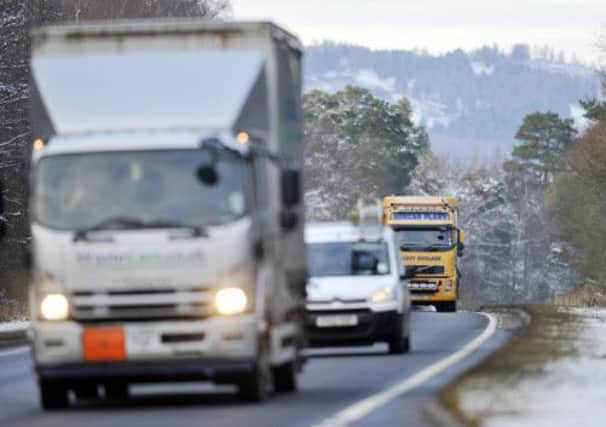Rail freight plans may hit the buffers


I was delighted to witness the launch of the Lifting the Spirit trial whisky train service from Elgin to Grangemouth last month – a tangible example of how rail could be attracting freight away from Scotland’s trunk roads.
In the longer term, the new train service has the potential to secure a significant freight modal switch away from the A95 and A9 roads on to rail services to Central Scotland. But, worryingly, moves to increase lorry speed limits on the A9 could undermine this innovative attempt to take advantage of safer and more sustainable rail freight.
Advertisement
Hide AdAdvertisement
Hide AdLifting the Spirit is a collaboration between big distilling companies such as Diageo and Pernod Ricard, the rail industry, Highlands & Islands Enterprise, local authorities and the European Union Foodport project to improve the logistics of food and drink distribution and to cut carbon emissions. An added incentive is that the initiative might help to cut the toll of fatalities and injuries on the A9.
Strengthening the whisky supply chain in Scotland
In the long term, rail can best serve the logistics needs of the whisky industry by securing direct rail connection to key Central Scotland whisky maturation/bottling plants and to big distilleries such as Cameron Bridge, Girvan, Invergordon and Roseisle. The Scottish Government’s sensible reprieve for the freight facilities grants scheme means public funding should be available to assist with capital investment schemes which will, crucially, allow the elimination of the road delivery leg at the end of the rail trunk haul.
The strategic strengthening of the whisky supply chain in Scotland will take some years, however. If, in the meantime, lorries are permitted to travel at 50mph rather than 40mph on single-carriageway sections of the A9, there is a real worry that this will significantly undermine rail’s ability to compete with road haulage.
Past modal switch from road to rail on the Highland Main Line from Inverness to Perth has come from “blue-chip” companies such as Tesco, which require road hauliers to observe the law – and the switch to rail has partly stemmed from a wish to avoid delaying car drivers. If the HGV speed limit on the A9 is raised, this is bound to have an adverse impact on the competitive economics of rail – and if some current freight on rail switches to road, then there is the danger that increased injuries and deaths will result.
Research undertaken for the A9 Safety Group (which includes the Freight Transport Association, Police Scotland and the Road Haulage Association) found that HGVs above 7.5 tonnes in weight are involved in 23 per cent of all accidents on single carriageway sections of the road, yet typically only make up 7 per cent of the traffic. It concluded that retaining the 40mph speed limit for HGVs “is the safest option”, in conjunction with average speed cameras. Why then have some politicians and some sections of the media been attacking speed cameras and arguing for the HGV speed limit to be increased?
The potential for more rail freight isn’t limited to the Highlands. Following major investment, Aberdeen now has three modern railheads – but other than the daily train operated from Grangemouth conveying Asda supermarket supplies and chemicals for the offshore oil industry, rail has found it difficult to break into markets beyond its traditional strengths in bulk products.
Rail industry may have to be more innovative
Route infrastructure is part of the problem – there aren’t enough long “refuging loops”, or passing areas, to allow 100mph passenger trains to overtake the longest (and hence most viable) freight trains between Aberdeen and Central Scotland.
But the rail industry may also have to be more innovative to help compete with road haulage. Currently, three rail hauliers serve the city, limiting the frequency of service that can be offered to any one customer – so might there be scope for a sharing of train capacity to maximise the rail offer in the marketplace?
Advertisement
Hide AdAdvertisement
Hide AdEn route from Aberdeen to Central Scotland, Dundee is one of the largest cities in Britain with no rail freight facilities. Yet an ideal low-cost start-up site for rail freight handling at Dundee West, convenient for main roads and city centre supermarkets – with ample sidings and space for road-to-rail transfer and container storage – sits unused, in part because the location is not favoured by city planners.
There is no “silver bullet” to secure more freight on rail in Scotland. Government, local authorities, regional transport partnerships, development agencies, the rail industry and potential customers all have a role to play. But greater commitment, innovation and “joined-up thinking” are needed if we are to reap the major economic, environmental and safety benefits of a substantial switch from road haulage to rail freight.
• David Spaven is the Scottish representative of the Rail Freight Group, www.rfg.org.uk